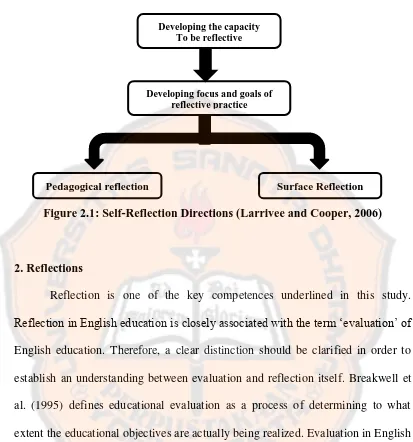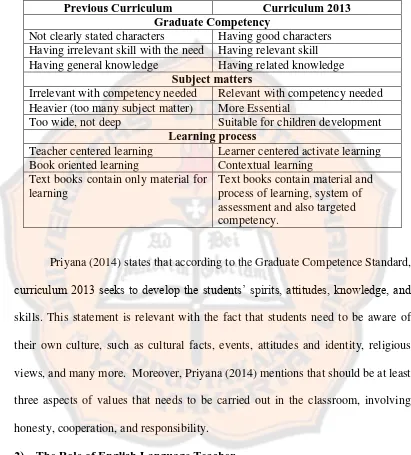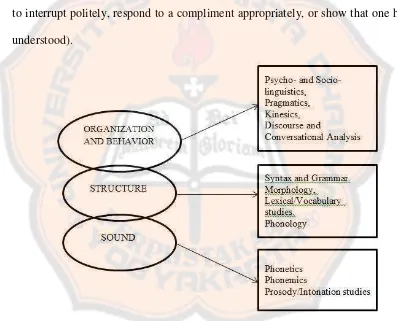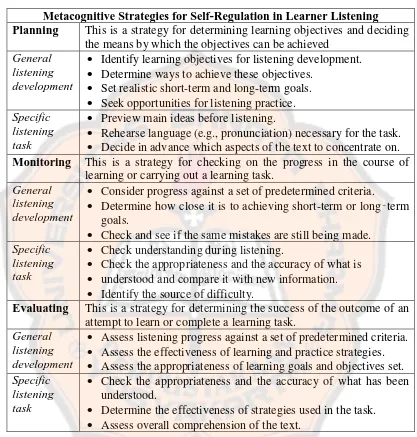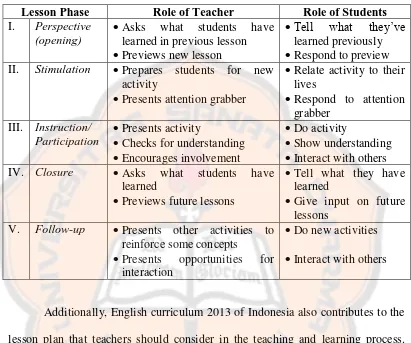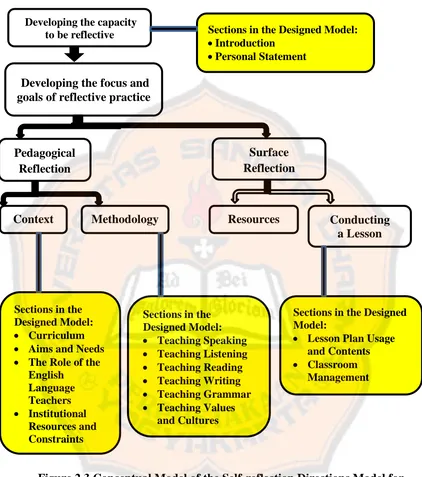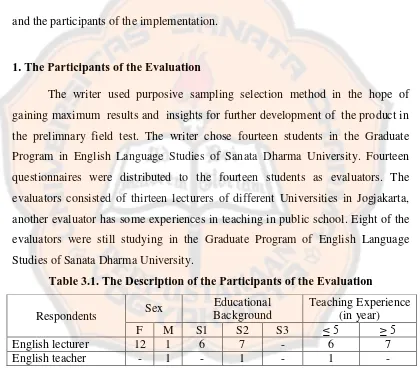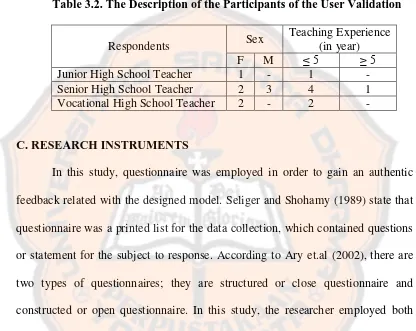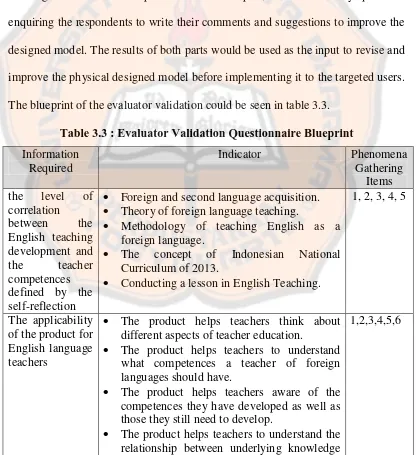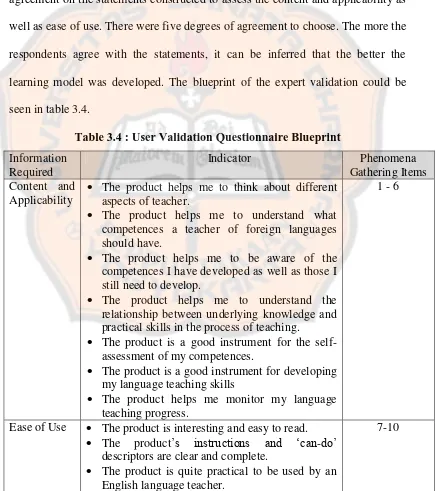xv
ABSTRACT
Biyandi, Wendy Rahmad. 2014. A Self-reflection Directions Model for English Language Teaching Development. Yogyakarta: Graduate Program on English Language Studies, Sanata Dharma University.
Teaching development is one of the crucial aspects that a teacher needs to gradually improve with efforts. Effective teaching is actually a tough and a challenging job where teachers have to develop themselves continuously in order to be able to teach appropriately. Several studies show that formal teaching development program, such as workshop or seminar, has not been effectively contributing to teachers’ performance and competence. From the point of view of informal teaching development, studies show that there are still many teachers who are discouraged to develop themselves through conducting self-reflection journal writing, and many more.
Today’s language classroom can be vastly different from that of the previous curriculum. The current National curriculum of 2013 will be definitely adjusted to the effective English language teaching and learning. English language teachers require something that is effectively able to help them identify what kinds of ideal curriculum, teaching methods, techniques and strategies, teaching resources, and many other as indicators that teachers can use to measure their teaching development. This research aims at designing a teacher reflection model that can effectively and practically help them to develop their English language teaching.
Two research problems were formulated, as follows: (1) What is the theoretical model of self-reflection directions for English language teaching development like?, (2) What is the model of self-reflection directions for English language teaching development like? To answer the research questions, Larrivee
and Cooper’s reflection model was adapted and selected as the conceptual framework to design the model. The phases of designing the reflection design model were incorporated into Borg and Gall’s cycles of Research and Development. Two surveys were administered in the development process. The first survey or the evaluators’ validation was conducted by distributing a questionnaire to fourteen students of the Graduate Program of English Language Studies, Sanata Dharma University. A prospective users’ questionnaire was then given to eight English language teachers from several schools. At the end, the data were used to improve the designed reflection model.
The theoretical model presents the designed reflection model contents that were synthesized according to their suitability with the theory of reflections as well as English language teaching methodology. The model was developed by making some revisions based on the results of the evaluators’ validation and prospective users’ validation. The study resulted on a model of self-reflection which contains three major sections: introduction, personal statement, and main contents.
xvi
language teachers. The teacher participants mostly stated that the designed reflection model was such a good, clear and complete reflection instrument that helps them monitor their progress in teaching English.
xvii
ABSTRAK
Biyandi, Wendy Rahmad. 2014. A Self-reflection Directions Model for English Language Teaching Development. Yogyakarta: Program Pasca-Sarjana Kajian Bahasa Inggris, Universitas Sanata Dharma.
Pengembangan pengajaran adalah salah satu aspek yang harus ditingkatkan oleh guru secara terus menerus. Pengajaran yang profesional merupakan sebuah tantangan dan pekerjaan yang berat dimana guru harus mengembangkan kemampuan mengajar mereka agar lebih efektif. Penelitian menunjukkan bahwa program pengembangan pengajaran yang formal seperti workshop atau seminar belum efektif membantu guru dalam mengembangkan kemampuan dan kompetensi mereka. Dari segi pengembangan pengajaran tidak formal, penelitian menunjukkan bahwa masih banyak guru yang belum aktif untuk mengembangkan kemampuan mengajar mereka sendiri seperti dengan berefleksi diri, mengisi jurnal refleksi, dan lainnya.
Pengajaran bahasa di jaman sekarang sudah berbeda dengan kurikulum sebelumnya. Konesep kurikulum 2013 yang sekarang ini pun akan menyesuaikan dengan pengajaran bahasa Inggris yang efektif. Guru bahasa Inggris memerlukan suatu sarana yang dapat membantu mereka dalam mengenali lebih jauh tentang kurikulum, metode dan tekhnik pengajaran, fasilitas pengajaran, dan indicator lainnya yang mana dapat menjadi acuan untuk memantau perkembangan pengajaran mereka sendiri. Penelitian ini bertujuan untuk mendisain sebuah model untuk membantu guru dalam merefleksikan diri agar guru dapat mengembangkan kemampuan mengajar bahasa Inggris.
Ada dua rumusan masalah yang disusun: (1) Seperti apakah model teoritis dari refleksi mandiri guru bahasa Inggris untuk pengembangan pengajaran? (2) Seperti apakah model ikonik dari refleksi mandiri guru bahasa Inggris untuk pengembangan pengajaran? Untuk menjawab rumusan masalah tersebut, model refleksi ditetukan sebagai rangka dasar teoritis untuk mendisain model refleksinya. Tahap yang digunakan untuk mendisain model refleksinya akan dikolaborasikan dengan siklus penelitian dan pengembangan Borg dan Gall. Dalam penelitian ini, penulis melakukan dua kali survey. Survey pertama merupakan survey pengesahan dari para evaluator, yang mana kuesioner diberikan kepada empat belas mahasiswa Kajian Bahasa Inggris Universitas Sanata Dharma. Survey kedua merupakan pengesahan calon pengguna produk, yang mana kuesioner diberikan kepada delapan guru bahasa Inggris dari berbagai sekolah.Terakhir, Hasil dari kedua data yang didapatkan akan digunakan untuk mengembangkan model refleksi yang telah didisain.
xviii
Hasil dari evaluasi produk menunjukaan bahwa model refleksi yang telah didisain cukup bagus digunakan dan merupakan alat refleksi diri yang bagus untuk guru bahasa Inggris. Para guru sebagai pengguna produk mengatakan bahwa model refleksinya sangat bagus, jelas, dan lengkap, yang mana dapat membantu guru dalam memantau perkembangan pengajaran bahasa Inggris mereka.
A SELF-REFLECTION DIRECTIONS MODEL FOR ENGLISH
LANGUAGE TEACHING DEVELOPMENT
A THESIS
Presented as a Partial Fulfillment of the Requirements
to Obtain the Magister Humaniora (M.Hum.) Degree
in English Language Studies
by
Wendy Rahmad Biyandi Student Number: 126332034
THE GRADUATE PROGRAM OF ENGLISH LANGUAGE STUDIES
SANATA DHARMA UNIVERSITY
YOGYAKARTA
i
A SELF-REFLECTION DIRECTIONS MODEL FOR ENGLISH
LANGUAGE TEACHING DEVELOPMENT
A THESIS
Presented as a Partial Fulfillment of the Requirements
to Obtain the Magister Humaniora (M.Hum.) Degree
in English Language Studies
by
Wendy Rahmad Biyandi Student Number: 126332034
THE GRADUATE PROGRAM OF ENGLISH LANGUAGE STUDIES
SANATA DHARMA UNIVERSITY
YOGYAKARTA
ii
A THESIS
A SELF-REFLECTION DIRECTIONS MODEL FOR ENGLISH
LANGUAGE TEACHING DEVELOPMENT
by
Wendy Rahmad Biyandi
Student Number: 126332034
Approved by
Dr. J. Bismoko
iii
A THESIS
A SELF-REFLECTION DIRECTIONS MODEL FOR ENGLISH
LANGUAGE TEACHING DEVELOPMENT
Presented by Wendy Rahmad Biyandi Student Number: 126332034
Defended before the Thesis Committee and Declared Acceptable.
THESIS COMMITTEE
Chairperson : Dr. J. Bismoko __________________
Secretary : F.X. Mukarto, Ph.D. __________________
Member : Dr. B.B. Dwijatmoko, M.A. __________________
Member : Markus Budi Raharjo, Ed.D __________________
Yogyakarta, February 27, 2015 The Graduate Program Director Sanata Dharma University
iv
STATEMENT OF WORK‘S ORIGINALITY
This is to certify that all ideas, phrases, sentences, unless otherwise stated, are the
ideas, phrases, and sentences of the thesis writer. The writer understands the full
consequences including degree cancellation if he took somebody else’s ideas,
phrases, sentences without proper references.
Yogyakarta, Desember 15, 2014
v
LEMBAR PERNYATAAN PERSETUJUAN
PUBLIKASI KARYA ILMIAH UNTUK KEPENTINGAN AKADEMIS
Yang bertanda tangan dibawah ini, saya mahasiswa Universitas Sanata Dharma:
Nama : Wendy Rahmad Biyandi
NIM : 12 6332 034
Demi pengembangan ilmu pengetahuan, saya memberikan kepada Perpustakaan
Universitas Sanata Dharma karya ilmiah saya yang berjudul:
A SELF-REFLECTION DIRECTIONS MODEL FOR ENGLISH
LANGUAGE TEACHING DEVELOPMENT
beserta perangkat yang diperlukan (bila ada). Dengan demikian, saya memberikan
kepada Perpustakaan Universitas Sanata Dharma hak untuk menyimpan,
mengalihkan dalam bentuk media lain, mengelolanya dalam bentuk pangkalan
data, mendistribusikannya di Internet atau media lain untuk kepentingan akademis
tanpa perlu meminta ijin maupun memberikan royalty kepada saya selama tetap
mencantumkan nama saya sebagai penulis.
Demikian pernyataan ini saya buat dengan sebenarnya.
Dibuat di Yogyakarta
Pada tanggal :
Yang menyatakan
vi
ACKNOWLEDGEMENTS
It will be a wonderful opportunity for me to express my deepest gratitude
to all of those who have supported and facilitated me in accomplishing this thesis.
First and foremost, my greatest gratitude is addressed to GOD the Almighty who
has given me His blessing so that I can finish my thesis and study.
I would like to express my heartfelt gratitude to my thesis advisor, Dr. J.
Bismoko, for being a source of guidance and insight. He taught me to think
globally, rather than locally, and encouraged me to always seek knowledge
beyond my own boundaries. I am deeply grateful to all the lecturers in English
Language Studies: Dr. B.B. Dwijatmoko, M.A. and Drs. F.X. Mukarto, M.S.,
Ph.D. for their guidance and knowledge they have shared.
I am truly indebted to Maria Delfina Dhae, Maria Asumpta Deny
Kusumaningrum, Ika Wahyuni Lestari, Paulina Erawati Paramita, Yustinus
Calvin Gai Mali, Fransisca Kristanti, Agatha Piscesia Paskalin, Sri
Hariyatmi, Maria Septiyani, Luluk Iswati, Bayu Aribowo, Cicilia Dwi
Setyorini, Fitria Rahmawati, and Anesti Budi Ermerawati for willingly
spending their time evaluating my designed reflection model.
Many thanks are addressed to all of the user teachers, Laurensius Bretya
Anindito, Dwi Yulianto Nugroho, Catharina Brameswari, Dinar Ratnasari,
Gunarso Sarwoko, Valentina Dyah Arum Sari, Nindyah Pratiwi, and Gloria
Rosario Putri for becoming the participants to administer my designed reflection
vii
I would like to give my deepest love and special thanks to my dearest one,
Pipit Indri Astuti. I thank her for her never-ending love and support. I would not
be where I am and who I am right now without the endless support she has given
to me all these years.
viii
TABLE OF CONTENTS
Page
TITLE PAGE ... i
APPROVAL PAGES ... ii
STATEMENT OF WORK’S ORIGINALITY ... iv
LEMBAR PERNYATAAN PERSETUJUAN PUBLIKASI ... v
ACKNOWLEDGEMENTS ... vi
TABLE OF CONTENTS ... viii
LIST OF TABLES ... xi
LIST OF FIGURES ... xiii
LIST OF APPENDICES ... xiv
ABSTRACT ... xv
ABSTRAK ... xvii
CHAPTER I : INTRODUCTION 1
A. RESEARCH BACKGROUND ... 1
B. PROBLEM IDENTIFICATION ... 7
C. PROBLEM LIMITATION ... 8
D. RESEARCH QUESTIONS ... 9
E. GOAL OF RESEARCH AND DEVELOPMENT ... 10
F. PRODUCT SPECIFICATIONS ... 10
ix
CHAPTER II : REVIEW OF LITERATURE ... 14
A. THEORETICAL REVIEW ... 14
1. Self-reflection Directions Design Model ... 14
2. Reflections ... 16
3. Teaching Development ... 22
a. Teaching Context ... 23
b. English Language Teaching Methodology ... 27
c. Conducting a Lesson ... 42
4. Related Studies ... 48
B. THEORETICAL FRAMEWORK ... 50
CHAPTER III : METHODOLOGY ... 55
A. RESEARCH METHOD ... 55
B. RESEARCH PARTICIPANTS ... 61
C. RESEARCH INSTRUMENTS ... 62
D. DATA GATHERING TECHNIQUE ... 65
E. DATA ANALYSIS TECHNIQUE ... 66
F. RESEARCH PROCEDURE ... 69
CHAPTER IV : RESEARCH FINDINGS AND DISCUSSION ... 71
A. THEORETICAL MODEL OF THE ENGLISH LANGUAGE TEACHING REFLECTION ... 71
x
a. Developing the Capacity to be Reflective ... 73
b. Developing the Focus and Goals of Reflective Practice ... 74
2. Planning ... 79
a. Introduction ... 79
b. Personal Statement ... 82
c. Main Contents ... 83
B. MODEL OF THE ENGLISH LANGUAGE TEACHING REFLECTION ... 93
1. Developing Preliminary Product ... 94
a. Introduction Layout Design ... 94
b. Personal Statement Layout Design ... 97
c. Main Contents Layout Design ... 99
2. Preliminary Field Testing ... 101
3. Main Product Revision ... 106
4. Main Field Testing ... 111
5. Evaluation ... 117
CHAPTER V : CONCLUSIONS AND SUGGESTIONS ... 119
A. CONCLUSIONS ... 119
B. SUGGESTIONS ... 123
BIBLIOGRAPHY ... 125
xi
LIST OF TABLES
Page
Table 2.1. Transformation of Curriculum in Indonesia ... 25
Table 2.2. Metacognitive Strategies for Self-Regulation in Learner Listening 32 Table 2.3. Generic Components of a Lesson Plan ... 44
Table 3.1. The Description of the Participants of the Evaluation ... 61
Table 3.2. The Description of the Participants of the User Validation ... 62
Table 3.3. Evaluator Validation Questionnaire Blueprint ... 63
Table 3.4. User Validation Questionnaire Blueprint ... 64
Table 3.5 Descriptive Statistics of Evaluators’ Opinions on the Designed Model Prototype Template ... 67
Table 3.6 The Interpretation of the Degree of Agreement ... 67
Table 3.7 The Rules of Answer Weight Standard ... 68
Table 3.8 The Meaning of Score Criteria ... 69
Table 4.1 The Reflection Items of Teaching Context Section ... 83
Table 4.2 The Reflection Items of Teaching Speaking ... 85
Table 4.3 The Reflection Items of Teaching Listening ... 87
Table 4.4 The Reflection Items of Teaching Reading ... 88
Table 4.10 Meaning of Point of Correlation/Agreement ... 102
Table 4.11 The Descriptive Statistics of Correlation between the Designed Model ... 103
Table 4.12 The Descriptive Statistics of the Participants Agreement about the applicability of the Designed Model ... 104
xii
Table 4.14 Main Product Revision –‘Values and Cultures’ Reflection Section Input ... 107
Table 4.15 The Description of the Main Field Testing of the Designed Model 112
Table 4.16 The Rules of Answer Weight Standard ... 112
Table 4.17 The Meaning of Score Criteria ... 113
xiii
LIST OF FIGURES
Page
Figure 2.1 Self-Reflection Directions ... 16
Figure 2.2 Levels and Fields of Research into Speech and Conversation ... 29
Figure 2.3 Conceptual Model of the English Language Teacher Reflection for Teaching Development ... 54
Figure 4.1 Self-Reflection Directions ... 72
Figure 4.2 Modified Self-Reflection Directions ... 78
Figure 4.3 The Introductory Page ... 95
Figure 4.4 Instruction ... 96
Figure 4.5 Teacher Profile ... 97
Figure 4.6 Personal Statement – Initial Reflection ... 98
Figure 4.7 Personal Statement – Checklist and Comments ... 99
Figure 4.8 Main Contents – Brief Description ... 100
Figure 4.9 Main Contents – Reflection Items ... 100
Figure 4.10 Main Product Revision –‘Brief Rationale’ Input ... 108
xiv
LIST OF APPENDICES
APPENDIX 1 The Result of Evaluators Validation Questionnaire Sample . 129
APPENDIX 2 The Result of Open-Ended Questions of the
Evaluators Validation ... 134
APPENDIX 3 The Result of User Validation Questionnaire Sample ... 144
APPENDIX 4 The Result of Open-Ended Questions of the User Validation 147
xv
ABSTRACT
Biyandi, Wendy Rahmad. 2014. A Self-reflection Directions Model for English Language Teaching Development. Yogyakarta: Graduate Program on English Language Studies, Sanata Dharma University.
Teaching development is one of the crucial aspects that a teacher needs to gradually improve with efforts. Effective teaching is actually a tough and a challenging job where teachers have to develop themselves continuously in order to be able to teach appropriately. Several studies show that formal teaching development program, such as workshop or seminar, has not been effectively contributing to teachers’ performance and competence. From the point of view of informal teaching development, studies show that there are still many teachers who are discouraged to develop themselves through conducting self-reflection journal writing, and many more.
Today’s language classroom can be vastly different from that of the previous curriculum. The current National curriculum of 2013 will be definitely adjusted to the effective English language teaching and learning. English language teachers require something that is effectively able to help them identify what kinds of ideal curriculum, teaching methods, techniques and strategies, teaching resources, and many other as indicators that teachers can use to measure their teaching development. This research aims at designing a teacher reflection model that can effectively and practically help them to develop their English language teaching.
Two research problems were formulated, as follows: (1) What is the theoretical model of self-reflection directions for English language teaching development like?, (2) What is the model of self-reflection directions for English language teaching development like? To answer the research questions, Larrivee
and Cooper’s reflection model was adapted and selected as the conceptual framework to design the model. The phases of designing the reflection design model were incorporated into Borg and Gall’s cycles of Research and Development. Two surveys were administered in the development process. The first survey or the evaluators’ validation was conducted by distributing a questionnaire to fourteen students of the Graduate Program of English Language Studies, Sanata Dharma University. A prospective users’ questionnaire was then given to eight English language teachers from several schools. At the end, the data were used to improve the designed reflection model.
The theoretical model presents the designed reflection model contents that were synthesized according to their suitability with the theory of reflections as well as English language teaching methodology. The model was developed by making some revisions based on the results of the evaluators’ validation and prospective users’ validation. The study resulted on a model of self-reflection which contains three major sections: introduction, personal statement, and main contents.
xvi
language teachers. The teacher participants mostly stated that the designed reflection model was such a good, clear and complete reflection instrument that helps them monitor their progress in teaching English.
xvii
ABSTRAK
Biyandi, Wendy Rahmad. 2014. A Self-reflection Directions Model for English Language Teaching Development. Yogyakarta: Program Pasca-Sarjana Kajian Bahasa Inggris, Universitas Sanata Dharma.
Pengembangan pengajaran adalah salah satu aspek yang harus ditingkatkan oleh guru secara terus menerus. Pengajaran yang profesional merupakan sebuah tantangan dan pekerjaan yang berat dimana guru harus mengembangkan kemampuan mengajar mereka agar lebih efektif. Penelitian menunjukkan bahwa program pengembangan pengajaran yang formal seperti workshop atau seminar belum efektif membantu guru dalam mengembangkan kemampuan dan kompetensi mereka. Dari segi pengembangan pengajaran tidak formal, penelitian menunjukkan bahwa masih banyak guru yang belum aktif untuk mengembangkan kemampuan mengajar mereka sendiri seperti dengan berefleksi diri, mengisi jurnal refleksi, dan lainnya.
Pengajaran bahasa di jaman sekarang sudah berbeda dengan kurikulum sebelumnya. Konesep kurikulum 2013 yang sekarang ini pun akan menyesuaikan dengan pengajaran bahasa Inggris yang efektif. Guru bahasa Inggris memerlukan suatu sarana yang dapat membantu mereka dalam mengenali lebih jauh tentang kurikulum, metode dan tekhnik pengajaran, fasilitas pengajaran, dan indicator lainnya yang mana dapat menjadi acuan untuk memantau perkembangan pengajaran mereka sendiri. Penelitian ini bertujuan untuk mendisain sebuah model untuk membantu guru dalam merefleksikan diri agar guru dapat mengembangkan kemampuan mengajar bahasa Inggris.
Ada dua rumusan masalah yang disusun: (1) Seperti apakah model teoritis dari refleksi mandiri guru bahasa Inggris untuk pengembangan pengajaran? (2) Seperti apakah model ikonik dari refleksi mandiri guru bahasa Inggris untuk pengembangan pengajaran? Untuk menjawab rumusan masalah tersebut, model refleksi ditetukan sebagai rangka dasar teoritis untuk mendisain model refleksinya. Tahap yang digunakan untuk mendisain model refleksinya akan dikolaborasikan dengan siklus penelitian dan pengembangan Borg dan Gall. Dalam penelitian ini, penulis melakukan dua kali survey. Survey pertama merupakan survey pengesahan dari para evaluator, yang mana kuesioner diberikan kepada empat belas mahasiswa Kajian Bahasa Inggris Universitas Sanata Dharma. Survey kedua merupakan pengesahan calon pengguna produk, yang mana kuesioner diberikan kepada delapan guru bahasa Inggris dari berbagai sekolah.Terakhir, Hasil dari kedua data yang didapatkan akan digunakan untuk mengembangkan model refleksi yang telah didisain.
xviii
Hasil dari evaluasi produk menunjukaan bahwa model refleksi yang telah didisain cukup bagus digunakan dan merupakan alat refleksi diri yang bagus untuk guru bahasa Inggris. Para guru sebagai pengguna produk mengatakan bahwa model refleksinya sangat bagus, jelas, dan lengkap, yang mana dapat membantu guru dalam memantau perkembangan pengajaran bahasa Inggris mereka.
1 CHAPTER I
INTRODUCTION
This thesis aims to develop a reflection tool model for English language
teachers. To ensure that this research is a valid and feasible project, this chapter
covers eight sections, namely: research background, problem identification,
research limitation, research questions, research goals, product specification and
research benefits, respectively.
A. RESEARCH BACKGROUND
Teaching development is one of the crucial aspects that a teacher needs to
gradually improve with efforts. Professional teaching is actually a tough and a
challenging job where teachers have to develop themselves continuously in order
to be able to teach effectively. In line with the developmental era of English
education, including teaching methods, techniques and strategies as well as the
changing curriculum of every nation, English teachers are becoming more
responsible for this condition. Professional development is categorized into two
main types, namely formal and informal development (Reimers, 2003). The first
is formal development, which provides formal experiences to add teacher
qualifications and is often linked to the teachers’ career. The second is informal
experiences, which consist of self-development and cooperative development and
are not linked to formal credits.
Formal development, such as in-service training programs, workshop,
professional competence since initial training is not enough to support teachers to
function in the best performance. Fry, et. al (2009) emphasize that some
academics teach students without having much formal knowledge of how students
learn. In the case of English education, it is very difficult to conceptualize ‘how
do the students learn’ and ‘how as teachers can they bring about learning’ since
education deals with specific purposes and contexts that differ from each other
and with students as people. In-service training, on one hand, is an important
program to raise teachers’ professional competence where it will raise teachers’
professional status through seminars, conferences, and short courses. This kind of teachers development program will give teachers opportunity to hear first-hand information on what is happening in English language teaching development and exchange experiences and ideas with other teachers. However, it is inevitable that such in-service workshops designed to improve teaching skills often have only short-term effects and rarely involve teachers in an ongoing process of examining their teaching (Richards and Lockhart, 1996).
development, teachers will be able to obtain considerable information through the process of exploring teaching. Regardless of how much experience a teacher has been through in teaching English in his or her institution, a teacher will eventually have to
define ‘what teacher am I?’ Understanding one’s own assumptions about teaching as
well as one's own teaching practices can lead to a richer conceptualization of teaching and a better understanding of teaching and learning processes (Richards and Lockhart, 1996). Exploring how critical a teacher manages to understand his or her own teaching practices can serve as a basis for self-evaluation and is therefore an important component of professional development. However, encouraging a teacher to reflect on his or her own teaching practice is a great challenge that requires extra motivation and enthusiasm in order to make everything works. Teachers may have more encouragement to be participating on a teacher formal development programs since there are rewards given to them (Siddiqui, 2004). This fact is one of the perceptions of the teachers who are willing to participate the program despite the professional development continuation, which is the main aim of the program. Referring to the phenomena that there are many teachers who are less enthusiastic to join a professional development program, conducting an informal development including self-development is another big challenge for teachers to carry out since they basically have been burdened by the institution administrative works.
Teaching development cannot be separated from the English teaching
methods, techniques and strategies. Along with the demand of the globalization
era, there are other two significant aspects taken into account in the teaching
development, those are the changing curriculum and the improvement of
learner’s ability and potency in education. It is an education plan that should
emphasize competency of learners. Indonesia implements curriculum 2013
officially that reflects the competency of learners and it is similar with curriculum
based competence which concentrates with learner-centered. It is
competency-based curriculum that focuses on learners’ competency. On the other hand,
teachers have to be able to interpret ‘the curriculum’ in a manner that includes the processes by which teachers facilitate student learning (Fry, et. al, 2009). Teachers
have to be aware about the respective roles and responsibilities in the teaching and
learning contract stated in the curriculum. The more attention teachers pay to
curriculum design and development, the more likely it is teachers can provide
transparency for the students regarding the intended learning outcomes for the
institution. Moreover, the connection between technology and language use in
nowadays’ modern world becomes more demanding all language professionals to
reflect on the ways in which technology is changing the profession of English
language teaching in particular (Chapelle, 2003).
The changing curriculum and the development of the technology will
eventually urge teachers to adjust themselves appropriately, by which this is not
an easy action to accomplish. Various educational issues in Indonesia have been
occurred on an ongoing basis, involving the pros and cons of the applied
curriculums, system of assessments, and many more. In this case, teachers are
often becoming targets of blame for the perceived failures of public education
(Schon, 1987). Therefore, the need of professional teaching development is one
After all, there has been a gap between what appears in reality and the
formal or informal evaluation towards the professional teaching development.
Teachers tend to perceive either formal or informal teaching development
program as administrative things that does not seem to give an adequate incentive
and career development. Ironically, it has been obviously stated that such
development program is commonly acceptable and teachers need it to improve
their professional development (National Education Departement, 2012).
Teachers do acquire feedbacks from their superiors or colleagues.
Nevertheless, the feedbacks are often found to be highly questionable. Teachers
might appear to be the ones who work hard and are willing to work extra, or
probably appear to be the ones who can fulfill the institution’s administrative responsibilities as well as being free from the head of the institution’s or parents’ complains. This fact is true on one side, but on the other side, this is not
contributing to the teachers’ feedback in terms of teaching skills and
competencies. Teachers might acquire feedback from their students through the
students’ English competencies progress, students’ score achievements, or the students’ reactions in the classroom. However, these kinds of feedback are hardly
systematic since the teachers might not be aware of what things they have
improved and what things they have not improved. Eventually, teachers need to
answer the questions of ‘what teacher am I’ - in other words - reflect on the way
they have been teaching so far. One teacher might have an opinion that ‘I am good
in teaching speaking’ or ‘I am good in managing a lesson’, for instance.
perceiving his or her own teaching, it is not impossible that he or she will realize
some imperfections, such as ‘turns out I tend speak too much in some classes’ or ‘I never thought that my reactions to students depend much on my mood’, and so
on.
According to Finney (as cited in Richards and Renandya, 2002), education
in the view of neo-pragmatism is a mixed-focus which is concerned with the
products of learning (knowledge, skill or pattern or behavior) and with processes
of learning. Education requires the teachers and the learners to develop their
capacity and emerging demands. In developing the capacity, language teachers do
encounter several problems as what have been mentioned earlier, by which it can
continuously occur during the teaching process and it can even become parts of
the teaching. Although many teachers are aware of those problems, many of them
could find it difficult to properly identify them in order to be able to work on the
solutions.
An investigation on the development of research to help English language
teachers improve their teaching development is therefore necessary to be
conducted. As Fiharsono (2009) points out, education in this era requires
something which promotes classical humanism and productive behavior in order
to help either teachers or learners become active players in this dynamic world.
English language teachers require something that is effectively able to help them
identify what kinds of ideal curriculum, teaching methods, techniques and
strategies, teaching resources, and many other as indicators that teachers can use
model is believed to socially and scientifically improve life quality in the way that
it can help language teachers become more self-fulfilled. Additionally, English
language teachers also require a practical and encouraging guideline to foster
them reflect on their teaching development in order that they will not tend to think
that doing such self-evaluation is a burden or a boring thing. This research is
aimed at developing an English language teacher self-reflection tool for teaching
development. The result of this study is expected to be one of the resources to
expand the use of self-reflection instruments among English language teachers.
B. PROBLEM IDENTIFICATION
Based on the rationale stated in the research background section, an effort
to build up a self-reflection tool to help English language teachers improve their
teaching development is carried out. Reflection is one of the major evaluation in
English education. In line with evaluation, assessment and testing, reflection aims
at assigning value to a program, a component or goal achievement based on
gathered information for future decision-making. Reflection is mainly in the field
of informal professional development. According to the theoretical descriptions,
reflection can cover several aspects, including curriculum, teaching methodology,
teaching management, and so forth.
Reflection can help teachers achieve a better understanding of one's own
assumptions about teaching as well as one's own teaching practices (Richards and
Lockhart, 1996). Due to some administrative reasons, many English language
address that issue, an English language teacher reflection tool for teaching
development can be a suitable instrument to overcome the problem because a
more encouraging and practical concept is built up for effective use.
C. PROBLEM LIMITATION
It is important to highlight some of the limitations of the study. First, this
research focuses only on the research and development of a reflection tool for
English language teachers. Therefore, there is no experimental study conducted to
measure the teachers' progress of their teaching development after they have
experienced the reflection model. It will focus on the development and its
validation.
Second, in designing the contents that will be presented in the reflection
model, the goals, objectives, and scopes of the reflection aspects are arranged in
accordance with the Indonesian National curriculum 2013 as formulated currently
in Indonesia. Besides, this research will only focus on developing five sections of
reflection as it is based on the theoretical descriptions, namely: 1) context
(containing curriculum understanding), 2) methodology, 3) resources, and 4)
conducting a lesson.
Third limitation is related to the reason of selecting this type of reflection
model as the platform where the teaching reflection model will be developed. The
reflection model will consist of ‘can-do descriptors’ statement items as the basis
for the English language teachers to reflect their own teaching. The reason of
reflective teaching proposed by Larrivee and Cooper’s (2006) self-reflection directions. Larrivee and Cooper’s (2006) model of teaching reflection suggests several aspects that English language teachers need to consider upon
self-evaluating. The researcher also elaborates related theories about reflections and
many aspects of English language teaching methodology in order to adjust the
English teaching principles with the selected reflection design model. Since many
of the theories suggest that self-reflection requires teacher to ask him or herself
about performance and competence, the idea of designing reflection model that
contains self-reflection statements is emerged. The researcher puts an effort to
synthesize the whole theories of reflections as well as teaching methodology to
obtain and extract the reflection statements. Later on, the obtained reflection
statements are to be arranged more practically and systematically in order that
English language teachers can find it easy to use the model. To support and
improve the model, I examine several other review of related literatures in order
to validate the content and the applicability more specifically.
Fourth, the population used in the sampling of the research is also limited
to English teachers who teach in the level of Junior High School up to Senior
High School. Further explanation about the research subject will be elaborated
later on in the Chapter III.
D. RESEARCH QUESTIONS
This research proposes two questions to be answered, and thus being the
1. What is the theoretical model of self-reflection directions for English
language teaching development like?
2. What is the model of self-reflection directions for English language
teaching development like?
E. GOAL OF RESEARCH AND DEVELOPMENT
The objectives of the study are to answer the questions stated in the
Statement of Research Question, as follow:First, this research aims to present the
theoretical model that will serve as the basis for the development of the physical
form of the model. Next, this research aims to develop the practical or easy-to-use
model that can be implemented to the English language teachers.
F. PRODUCT SPECIFICATIONS
A model of self-reflection management system for English language
teachers will be established in a set of ‘can-do descriptors’ concept. It will serve
as a self-teaching reflection aid that helps English language teachers to monitor
their teaching progress. The product specification is explained through two main
sections that English language teachers can reflect on, namely the introduction
section and the main contents section. The introduction section provides some
brief explanation about what the product is all about, the rationale, as well as the
purposes of the product. Additionally, a sub-section called ‘personal statement’ is also provided to help teachers to reflect on general questions related to teaching,
and a self-reflection section. The main section highlights several English language
methodology, teaching management, and so on, that will guide teachers in
managing to have self-reflection. This section consists of ‘can-do’ descriptors in order to facilitate the teachers to reflect and to self-assess.
One of the greatest advantages in sticking with this self-reflection model is
that English language teachers are provided with various statements to reflect
based on specific aspects of English education. Teachers will not find it confusing
in how they would reflect since this model has provided ideal statements to be
used as a parameter to monitor the teaching progress. By using this model,
teachers are more encouraged to reflect on the competences a teacher needs to
strive to attain because teachers will be enlightened to understand what needs to
reflect on, rather than writing self-teaching diaries or journals without clear
identifications of standards.
Another benefit that can be gained through this model is that it can help
prepare teachers for a variety of teaching contexts. Teaching is a matter of
professional development; every teacher is required to gradually develop their
teaching over time. By exploring various teaching contexts provided in the
contents of the model, English language teachers can be challenged to improve
themselves even more. Another advantage is that this model looks forward to
promote discussion between teachers and peers. Exploring what needs to reflect
upon or improve will eventually encourage teachers and other colleagues to
discuss the teaching drawbacks and excellence.
Finally, to indicate how well an English teacher monitors his or her own
is also provided in order to make sense to the teachers on how they would know if
their ways of teaching are already proficient or still requiring improvements. This
ranging scale of indicator is clearly and specifically made to ease the teachers
during self-reflecting so that it will also save time and will not really burden the
teachers.
G. BENEFIT OF RESEARCH AND DEVELOPMENT
The research benefits of the study cover theoretical benefit and practical
benefits. Theoretically, the study is meant to provide scientific information in
education especially those related to evaluation in English education mainly in the
context of reflection. It would facilitate the new way of managing a self-reflection
by using a developed reflection model for enhancing teachers’ teaching development. There have been various kinds of reflective teaching theories which
serve as guidelines for language teachers to perform a self-reflection. However,
the self-reflection model developed in this study is intended for building a more
effective self-reflection practice for language teacher. It is also expected that this
study makes a contribution in helping language teachers develop a critical
thinking about how to successfully comprehend teaching development as it
eventually helps teachers attain their true professional development.
Practically, the study provides information about teaching aspects that
often become issues in teaching English language, such as curriculum
understanding, teaching methodology, and other principles related to language
in the contents of the designed model. The contents of the designed model will
encourage English language teachers to explore many aspects of teaching
development by managing to have a self-reflection according to the reflection
items provided. Here, the teachers are expected not to neglect such important
development that actually very beneficial not only for the teachers’ self
-development itself but also for the improvement of the students learning,
14 CHAPTER II
REVIEW OF RELATED LITERATURE
This chapter aims to discover the logical truths for designing the reflection
model. It consists of two sections: theoretical review, and theoretical framework.
The first section discusses the design model, reflections, teaching context,
teaching methodology, and conducting a lesson. Meanwhile, the second section
elaborates the framework synthesized from the discussed theories.
A. THEORETICAL REVIEW
In the theoretical review, the related and relevant theoretical descriptions
are provided in order to clarify concepts and their relations. The theoretical review
includes the design model, theory of reflections, teaching context, teaching
methodology, conducting a lesson, and related studies.
1. Self-reflection Directions Design Model
As mentioned earlier in chapter I, the purpose of this study is to design a
self-reflection model for English language teachers as a part of an program design.
The strategic planning applied to design the model is adapted from the Larrivee
and Cooper‘s self-reflection directions that involve several aspects that a
reflective teacher has to entail (2006). Larrivee and Cooper‘s self-reflection directions contain several stages and categorizations that cover many different
dimensions that a teacher should critically think about. The self—reflection
teacher to manage an in-depth reflection. Thus, the directions will be used as the
most appropriate strategic planning to design the self-reflection model for the
English language teachers since the conceptual framework is theoretically in line
with the aim of producing the model. However, in order to make the model of the
English language teacher reflection tool become more relevant, well-structured,
organized, clear, specific, and complete, there are several modifications that more
specifically elaborate the contents of the reflection.
Larrivee and Cooper‘s (2006) model of reflection directions is not specifically intended for English language teachers, it tends to be directed to
teachers in general. Therefore, beside assigning the conceptual framework of
Larrivee and Cooper‘s (2006) reflection directions model, the principles of
English language reflective teaching are also included to be adjusted appropriately
in the model. The self-reflection directions model will be used as the ground of
how theories described in this chapter are developed in order to be interrelated
that it constitutes a theoretical framework of understanding. The description of the
stages and the categorizations of the reflection directions proposed by Larrivee
Figure 2.1: Self-Reflection Directions (Larrivee and Cooper, 2006)
2. Reflections
Reflection is one of the key competences underlined in this study.
Reflection in English education is closely associated with the term ‗evaluation‘ of
English education. Therefore, a clear distinction should be clarified in order to
establish an understanding between evaluation and reflection itself. Breakwell et
al. (1995) defines educational evaluation as a process of determining to what
extent the educational objectives are actually being realized. Evaluation in English
education involves a process of assigning value to the achievement extent of the
goals of an educational program. Wiggins (1998) describes that in evaluating such
educational program, there is one technique of gathering data and information
called ‗assessment‘. According to Wiggins (1998), assessment is a method or
process of gathering information about an institution progress and achievement
towards the curriculum and goals. In an institution or school, the ones that are
periodically assessed are not only the students but also the other components, such
Developing the capacity To be reflective
Developing focus and goals of reflective practice
as the teachers, the resources, and many more. Teacher is one of the value
components that needs to be assigned. Since reflection has the purpose to develop
teacher‘s sense of how theory feeds into practice and is considered as the central
role to play in the cycle of teaching and learning (Green, 2011), reflection is
actually part of the evaluation in English education.
Reflection is closely related to a profession self-development, as it is stated
by Vasutova (2001), the ability of reflection and self-reflection is a part of
profession and personality cultivating competence (as cited in Brno, 2010). Every
teacher, including an English language teacher, is the one who takes the most
responsibility to elicit their effective teaching practice in order that a professional
development could be accomplished. An English teacher who encounters
problems regarding limited own linguistic competency and proficiency will more
likely result in low efforts to improve learners' achievement in English language
learning. Therefore, there is always a possibility that an English language teacher
may lack certain important qualities, identified by many researchers as
indispensable factors in becoming an efficient and effective English language
teacher. As Kabilan (2007) asserts, teacher, some of the identified factors are
fundamental pedagogical knowledge and understanding, awareness of meaningful
classroom practices, linguistic capabilities, positive attitudes, and relevant skills.
As all these qualification underline an effective and efficient English
language teacher, its absence might possibly interfere the teacher‘s development
in a long-term basis. The students‘ academic progress, such as rising scores or any
feedback that a teacher can reflect on. However, such experiences are insufficient
to develop the teacher‘s own qualities in teaching their students.
Reflection is careful and analytical thought by teachers about what they
are doing and the effects of their behavior on their instruction and on student
learning (Allwright, 1998). Reflection means that teachers have to think and
analyze what they have done or taught in the classroom by relating to their
previous experiential knowledge and received knowledge. Kabilan (2007)
emphasizes that the practice of reflection is deeply rooted in critical thinking and
is connected to external realities, enfolded with the practitioner's inner feeling.
The more teachers critically thinks about ‗what kinds of teacher am I‘, the more they will construct and develop their self-teaching development. Pollard and Tann
(1993) believe that the process of reflection feeds a constructive spiral of
professional development and competence.
Teacher who has a proficient English competence as well as good English
language teaching knowledge is assumed to be outrageously content with their
existing performance (Kabilan, 2007). In fact, teacher has to validate their ideas in
teaching or generate new knowledge that can eventually build a professional
development. Therefore, awareness on how a teacher has done in the classroom is
one thing that a teacher should critically highlight instead of merely being
proficient in English competence. Brno (2010) suggests that reflection can be
either intuitive or systematic and organized, it enables teachers to become aware
of their weak and strong points. Absence of such awareness would make a further
the strengths and weaknesses are, it should involve analysis of a searched area and
a plan of subsequent actions.
When applied to teaching, Wallace (1991) mentions the numerous
immediate interactions and decisions teachers make in the classroom every day
which are definitely not based on a direct application of ‗received knowledge‘, often satisfaction (or unease) is expressed in terms of feeling, rather than a
conscious application of principles‖. He adds that each professional performance
that raised especially positive or negative feelings should be followed by
reflection so that the teacher can either build on the positive aspects or avoid the
problems in the future. Reflection can lead to the conscious development of
insights into knowing-in-action (Wallace, 1991). Brno (2010) asserts that
naturally, each teacher is a part of a school and each school is a part of a
community. Even if a teacher concentrates basically only on their teaching in their
reflection, its effects can influence primarily the students in the class they teach
and secondarily the school eventually the society both the pupils and the teacher
are parts of.
Teacher‘s activities in the school and classroom cannot be separated from
what they are doing routinely and what they are doing reflectively. Pollard et al.
(2005) explain the concept of differences between ―routine action‖ and ―reflective
action‖. Routine action is influenced by tradition, habit and authority and by
institutional definitions and expectations, which is relatively static. While
development which implies flexibility, rigorous analysis and social awareness.
Pollard proposes seven key characteristics of the meaning of reflective practice.
First, reflective teaching implies an active concern with aims and
consequences, as well as means and technical efficiency. A teacher is not only
responsible for his/her own classroom practice but should be an active participant
in providing a critical feedback on educational policy of a state. Second, reflective
teaching is applied in a cyclical or spiralling process, in which teachers monitor,
evaluate and revise their own practice continuously. A teacher should overtake
responsibility for working on his or her development, the need for a change in
his/her practice should emerge from his or her self-reflection.
Third, reflective teaching requires competence in methods of
evidence-based classroom enquiry, to support the progressive development of higher
standards of teaching. A teacher should be familiar with methods that enable him
or her to collect information, analyse it and evaluate it. Fourth, reflective teaching
requires attitudes of open-mindedness, responsibility and wholeheartedness. Fifth,
reflective teaching is based on teacher judgement, informed by evidence-based
enquiry and insights from other research. Teachers are the ones who make
constant decisions and judgements in interaction with their pupils and situations in
schools and classrooms, however, they should not neglect the contributions of
professional researches; teachers and researchers should cooperate in their work.
Sixth, reflective teaching, professional learning and personal fulfilment are
enhanced through collaboration and dialogue with colleagues. Teachers are
teaching enables teachers to creatively mediate externally developed frameworks
for teaching and learning. Teachers should remember their own principles and
values when employing external demands into the specific context of their
teaching.
Every teacher in every institution works with different kinds of situations,
different kinds of materials delivery techniques, different approaches and
methods, and obviously different skills and experiences (Richards and Lockhart,
1996). It can be inferred that teacher‘s improvement in terms of knowledge, skills,
and experiences is pretty much relative. There are no single fixed-guidelines on
how to lead a teacher into an effective teaching. Rather, a teacher needs to
personally develop a critically reflective approach to teaching, which can be used
with any teaching method or approach. Richards and Lockhart (1996) define five
general assumptions that underline the reason why self-exploring teaching is
significant for professional development.
First, an informed teacher has an extensive knowledge base about
teaching. Teaching is a complex, multidimensional activity. The teacher who has
a more extensive knowledge and deeper awareness about the different
components and dimensions of teaching is better prepared to make appropriate
judgments and decisions in teaching. Second, much can be learned about teaching
through self-inquiry. For many teachers, classroom visits by supervisors are the
main source of feedback on their teaching. While comments of a supervisor or
other outside visitor can be a useful source of information about one's teaching,
Third, much of what happens in teaching is unknown to the teacher.
Teachers are often unaware of the kind of teaching they do or how they handle
many of the moment-to-moment decisions that arise. This is seen in the following
comments, which were made by teachers after watching videotapes of their own
lessons.
Fourth, experience is insufficient as a basis for development. While
experience is a key component of teacher development, in itself it may be
insufficient as a basis for professional growth. Fifth, critical reflection can trigger
a deeper understanding of teaching. Critical reflection involves examining
teaching experiences as a basis for evaluation and decision making and as a source
for change.
3. Teaching Development
In line with the selected reflection design model, there are at least two
aspects of reflection underlying language teachers‘ capacity to be reflective,
namely pedagogical and surface reflection. The pedagogical reflection cannot be
separated from beliefs about a program and the curriculum. As Richards and
Lockhart (1996) states, any language teaching program reflects both the culture of
the institution, as well as collective decisions and beliefs of individual teachers.
Moreover, Larrivee and Cooper (2006) suggest that language teachers should
understand the theoretical basis for classroom practice and to foster consistency
between the espoused theory (what they say they do and believe) and
reflection that involves teaching context, English language teaching methodology,
and conducting a lesson are described.
a. Teaching Context
The concept of context tends to refer to a broad social situation. Context,
such as the curriculum, the institutions, and the specific roles of the practitioners
will determine what an English language teacher should do. Tudor (2001) states
that language teaching and learning take place in a certain place or setting or
‗lived in a particular context‘ (as cited in Kabir, 2012). Kabir (2012) emphasizes
that teaching language cannot overlook the culture i.e. socio-political and
geopolitical aspect, institutional aspect of a country where the teacher teaches.
The current curriculum in Indonesia has been implementing the National
curriculum of 2013, by which the notions of this new curriculum cannot be
disregarded by English language teachers in particular. Teachers are increasingly
necessary to comprehend the personal, intellectual and cultural value of learning
English languages in the country or institution where they are teaching. Richards
(2005) explains the importance of curriculum studies that refers to a very broad
field of enquiry that deals with what happens in schools and other educational
institutions, the planning of instruction, and the study of how curriculum plans are
implemented. Therefore, beside being able to plan a certain possibility of overall,
long-term aims based on needs and expectations of English language learners,
teachers are also required to take into account on the expectations and impact of
1) Curriculum 2013
In Indonesia, The improvement of curriculum 2013 from ―curriculum for
each education unit‖ (Kurikulum Tingkat Satuan Pendidikan, abbreviated by
KTSP), to ―competency-based curriculum‖ according to Ministry of Education
and Culture is reflecting some principles. Those principles of improvement
curriculum are: a) curriculum must be designed by giving opportunity to learners
to improve the differences in skill and interest, b) curriculum must be centered on
potency, improvement, need, and benefit of learners and his environment;
curriculum must designed based on the principle that learners is on central
position and must be active while learning, c) curriculum must be perceptive to
change of knowledge, culture, technology and art, d) curriculum must be relevant
with need of life.
Through curriculum 2013 which is competency-based curriculum, there
are three domains that hoped to be transformed, namely; a) Graduate competency.
Curriculum 2013 expects the students to have good character, significant skill and
related knowledge. b) Subjects. Through curriculum 2013, subjects are demanded
to be relevant with needed competency, become more essential and suitable for
children development. c) Learning process. The transformations are described in
Table 2.1: Transformation of Curriculum in Indonesia
Modified from Pengembangan Kurikulum (Ministry of Education and Culture, 2012)
Previous Curriculum Curriculum 2013 Graduate Competency
Not clearly stated characters Having good characters Having irrelevant skill with the need Having relevant skill Having general knowledge Having related knowledge
Subject matters
Irrelevant with competency needed Relevant with competency needed Heavier (too many subject matter) More Essential
Too wide, not deep Suitable for children development Learning process
Teacher centered learning Learner centered activate learning Book oriented learning Contextual learning
Text books contain only material for learning
Text books contain material and process of learning, system of assessment and also targeted competency.
Priyana (2014) states that according to the Graduate Competence Standard,
curriculum 2013 seeks to develop the students‘ spirits, attitudes, knowledge, and
skills. This statement is relevant with the fact that students need to be aware of
their own culture, such as cultural facts, events, attitudes and identity, religious
views, and many more. Moreover, Priyana (2014) mentions that should be at least
three aspects of values that needs to be carried out in the classroom, involving
honesty, cooperation, and responsibility.
2) The Role of English Language Teacher
English language teachers work in a different context with different
functions of the development of the education. Richards and Rodgers (2001)
consider context as the ‗starting point in language program design‘. They
contexts; cultural context, political context, local institutional context, and context
constituted by the teachers and the learners in the classroom.
According to Kabir (2012), cultural context embodies the total set of
beliefs of the people of a particular society. It also refers to attitude, behavior,
social customs, and habits of the people of a society. English language teachers
are expected to appreciate and carry out the values added to the classroom
environment by learners with many and different cultural backgrounds. In
addition to being able to apply on appropriate theories of English language
teaching and learning, cultural context plays a big role in determining what
teachers take decisions in the school or the classroom. Richards (2001) describes
six core components that underline knowledge that a qualified teacher should
have.
First, practical knowledge: it is dealing with the teacher‘s repertoire if classroom techniques and strategies. Teacher has to take into account the
knowledge of the mother or first languages learners may already possess and help
them to build on this knowledge when learning English language. Second, content
knowledge: it is about the teacher‘s understanding of the subject of teaching
English, such as pedagogical grammar, phonology, teaching theories, second
language acquisition, as well as the specialized discourse and technology of
language teaching. Apart from teaching learning context, teachers have to apply
on appropriate theories of English language teaching and learning as well as
Third, contextual knowledge: the knowledge that has something to do with
the school or institutional context, school norms, and knowledge of the learners,
including cultural and other relevant information. This understanding might lead
the teachers to take into account the knowledge of the mother or first languages
learners may already possess and help them to build on this knowledge when
learning English language. Fourth, pedagogical knowledge: the ability to
restructure content knowledge for teaching purposes, and to plan, adapt, and
improve. Teachers have to be able to identify and investigate specific pedagogical
or didactic issues related to their learners or their teaching process in order to
make a plan for improvement.
Fifth, personal knowledge: it deals with the teachers‘ personal beliefs and principles and his or her individual approach to teaching. This will critically
assess the teachers‘ teaching process in relation to the theoretical principles.
Sixth, reflective knowledge: it covers the teachers‘ capacity to reflect on and
assess their teaching practice.
b. English Language Teaching Methodology
One of the most crucial aspects in teaching English as second or foreign
language learning is the teaching methodology. Teaching methodology basically
addresses issues related to English language teaching that are closely related to
both theory and practice. According to Richards and Renandya (2002), classroom
practitioners show not only how theory can inform classroom practice, but also
how the practical realities of teaching inform theory and research. As an English
